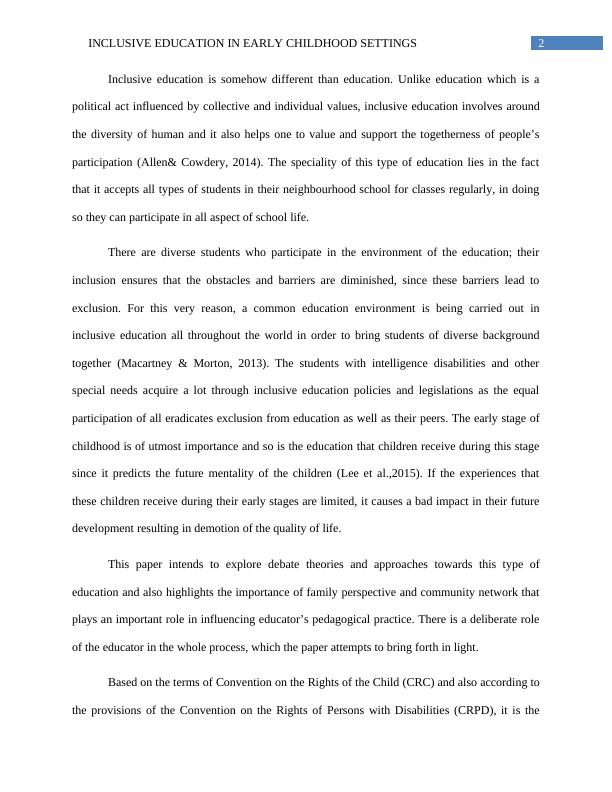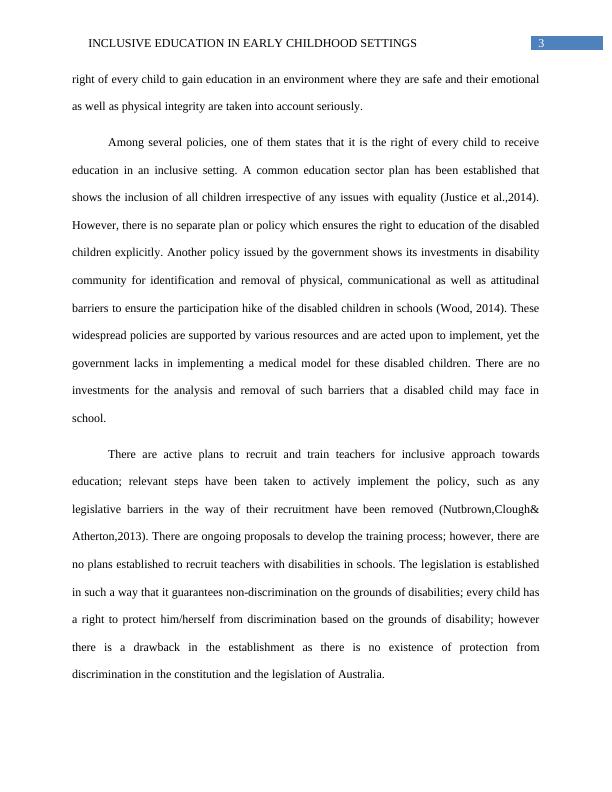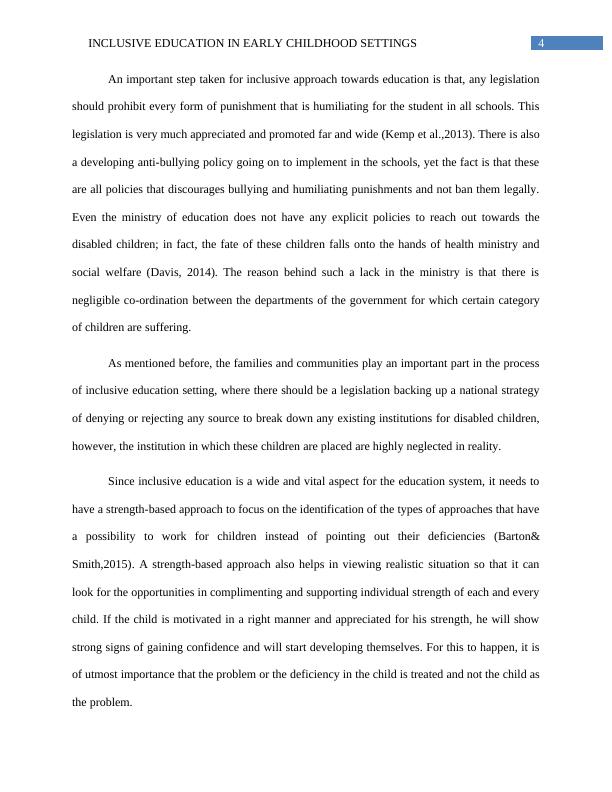Inclusive Education in Early Childhood Settings
Added on 2022-11-18
12 Pages3591 Words479 Views
Running head: INCLUSIVE EDUCATION IN EARLY CHILDHOOD SETTINGS
Inclusive Education in Early Childhood Settings
Name of the Student:
Name of the University:
Author Note:
Inclusive Education in Early Childhood Settings
Name of the Student:
Name of the University:
Author Note:

2INCLUSIVE EDUCATION IN EARLY CHILDHOOD SETTINGS
Inclusive education is somehow different than education. Unlike education which is a
political act influenced by collective and individual values, inclusive education involves around
the diversity of human and it also helps one to value and support the togetherness of people’s
participation (Allen& Cowdery, 2014). The speciality of this type of education lies in the fact
that it accepts all types of students in their neighbourhood school for classes regularly, in doing
so they can participate in all aspect of school life.
There are diverse students who participate in the environment of the education; their
inclusion ensures that the obstacles and barriers are diminished, since these barriers lead to
exclusion. For this very reason, a common education environment is being carried out in
inclusive education all throughout the world in order to bring students of diverse background
together (Macartney & Morton, 2013). The students with intelligence disabilities and other
special needs acquire a lot through inclusive education policies and legislations as the equal
participation of all eradicates exclusion from education as well as their peers. The early stage of
childhood is of utmost importance and so is the education that children receive during this stage
since it predicts the future mentality of the children (Lee et al.,2015). If the experiences that
these children receive during their early stages are limited, it causes a bad impact in their future
development resulting in demotion of the quality of life.
This paper intends to explore debate theories and approaches towards this type of
education and also highlights the importance of family perspective and community network that
plays an important role in influencing educator’s pedagogical practice. There is a deliberate role
of the educator in the whole process, which the paper attempts to bring forth in light.
Based on the terms of Convention on the Rights of the Child (CRC) and also according to
the provisions of the Convention on the Rights of Persons with Disabilities (CRPD), it is the
Inclusive education is somehow different than education. Unlike education which is a
political act influenced by collective and individual values, inclusive education involves around
the diversity of human and it also helps one to value and support the togetherness of people’s
participation (Allen& Cowdery, 2014). The speciality of this type of education lies in the fact
that it accepts all types of students in their neighbourhood school for classes regularly, in doing
so they can participate in all aspect of school life.
There are diverse students who participate in the environment of the education; their
inclusion ensures that the obstacles and barriers are diminished, since these barriers lead to
exclusion. For this very reason, a common education environment is being carried out in
inclusive education all throughout the world in order to bring students of diverse background
together (Macartney & Morton, 2013). The students with intelligence disabilities and other
special needs acquire a lot through inclusive education policies and legislations as the equal
participation of all eradicates exclusion from education as well as their peers. The early stage of
childhood is of utmost importance and so is the education that children receive during this stage
since it predicts the future mentality of the children (Lee et al.,2015). If the experiences that
these children receive during their early stages are limited, it causes a bad impact in their future
development resulting in demotion of the quality of life.
This paper intends to explore debate theories and approaches towards this type of
education and also highlights the importance of family perspective and community network that
plays an important role in influencing educator’s pedagogical practice. There is a deliberate role
of the educator in the whole process, which the paper attempts to bring forth in light.
Based on the terms of Convention on the Rights of the Child (CRC) and also according to
the provisions of the Convention on the Rights of Persons with Disabilities (CRPD), it is the

3INCLUSIVE EDUCATION IN EARLY CHILDHOOD SETTINGS
right of every child to gain education in an environment where they are safe and their emotional
as well as physical integrity are taken into account seriously.
Among several policies, one of them states that it is the right of every child to receive
education in an inclusive setting. A common education sector plan has been established that
shows the inclusion of all children irrespective of any issues with equality (Justice et al.,2014).
However, there is no separate plan or policy which ensures the right to education of the disabled
children explicitly. Another policy issued by the government shows its investments in disability
community for identification and removal of physical, communicational as well as attitudinal
barriers to ensure the participation hike of the disabled children in schools (Wood, 2014). These
widespread policies are supported by various resources and are acted upon to implement, yet the
government lacks in implementing a medical model for these disabled children. There are no
investments for the analysis and removal of such barriers that a disabled child may face in
school.
There are active plans to recruit and train teachers for inclusive approach towards
education; relevant steps have been taken to actively implement the policy, such as any
legislative barriers in the way of their recruitment have been removed (Nutbrown,Clough&
Atherton,2013). There are ongoing proposals to develop the training process; however, there are
no plans established to recruit teachers with disabilities in schools. The legislation is established
in such a way that it guarantees non-discrimination on the grounds of disabilities; every child has
a right to protect him/herself from discrimination based on the grounds of disability; however
there is a drawback in the establishment as there is no existence of protection from
discrimination in the constitution and the legislation of Australia.
right of every child to gain education in an environment where they are safe and their emotional
as well as physical integrity are taken into account seriously.
Among several policies, one of them states that it is the right of every child to receive
education in an inclusive setting. A common education sector plan has been established that
shows the inclusion of all children irrespective of any issues with equality (Justice et al.,2014).
However, there is no separate plan or policy which ensures the right to education of the disabled
children explicitly. Another policy issued by the government shows its investments in disability
community for identification and removal of physical, communicational as well as attitudinal
barriers to ensure the participation hike of the disabled children in schools (Wood, 2014). These
widespread policies are supported by various resources and are acted upon to implement, yet the
government lacks in implementing a medical model for these disabled children. There are no
investments for the analysis and removal of such barriers that a disabled child may face in
school.
There are active plans to recruit and train teachers for inclusive approach towards
education; relevant steps have been taken to actively implement the policy, such as any
legislative barriers in the way of their recruitment have been removed (Nutbrown,Clough&
Atherton,2013). There are ongoing proposals to develop the training process; however, there are
no plans established to recruit teachers with disabilities in schools. The legislation is established
in such a way that it guarantees non-discrimination on the grounds of disabilities; every child has
a right to protect him/herself from discrimination based on the grounds of disability; however
there is a drawback in the establishment as there is no existence of protection from
discrimination in the constitution and the legislation of Australia.

4INCLUSIVE EDUCATION IN EARLY CHILDHOOD SETTINGS
An important step taken for inclusive approach towards education is that, any legislation
should prohibit every form of punishment that is humiliating for the student in all schools. This
legislation is very much appreciated and promoted far and wide (Kemp et al.,2013). There is also
a developing anti-bullying policy going on to implement in the schools, yet the fact is that these
are all policies that discourages bullying and humiliating punishments and not ban them legally.
Even the ministry of education does not have any explicit policies to reach out towards the
disabled children; in fact, the fate of these children falls onto the hands of health ministry and
social welfare (Davis, 2014). The reason behind such a lack in the ministry is that there is
negligible co-ordination between the departments of the government for which certain category
of children are suffering.
As mentioned before, the families and communities play an important part in the process
of inclusive education setting, where there should be a legislation backing up a national strategy
of denying or rejecting any source to break down any existing institutions for disabled children,
however, the institution in which these children are placed are highly neglected in reality.
Since inclusive education is a wide and vital aspect for the education system, it needs to
have a strength-based approach to focus on the identification of the types of approaches that have
a possibility to work for children instead of pointing out their deficiencies (Barton&
Smith,2015). A strength-based approach also helps in viewing realistic situation so that it can
look for the opportunities in complimenting and supporting individual strength of each and every
child. If the child is motivated in a right manner and appreciated for his strength, he will show
strong signs of gaining confidence and will start developing themselves. For this to happen, it is
of utmost importance that the problem or the deficiency in the child is treated and not the child as
the problem.
An important step taken for inclusive approach towards education is that, any legislation
should prohibit every form of punishment that is humiliating for the student in all schools. This
legislation is very much appreciated and promoted far and wide (Kemp et al.,2013). There is also
a developing anti-bullying policy going on to implement in the schools, yet the fact is that these
are all policies that discourages bullying and humiliating punishments and not ban them legally.
Even the ministry of education does not have any explicit policies to reach out towards the
disabled children; in fact, the fate of these children falls onto the hands of health ministry and
social welfare (Davis, 2014). The reason behind such a lack in the ministry is that there is
negligible co-ordination between the departments of the government for which certain category
of children are suffering.
As mentioned before, the families and communities play an important part in the process
of inclusive education setting, where there should be a legislation backing up a national strategy
of denying or rejecting any source to break down any existing institutions for disabled children,
however, the institution in which these children are placed are highly neglected in reality.
Since inclusive education is a wide and vital aspect for the education system, it needs to
have a strength-based approach to focus on the identification of the types of approaches that have
a possibility to work for children instead of pointing out their deficiencies (Barton&
Smith,2015). A strength-based approach also helps in viewing realistic situation so that it can
look for the opportunities in complimenting and supporting individual strength of each and every
child. If the child is motivated in a right manner and appreciated for his strength, he will show
strong signs of gaining confidence and will start developing themselves. For this to happen, it is
of utmost importance that the problem or the deficiency in the child is treated and not the child as
the problem.

End of preview
Want to access all the pages? Upload your documents or become a member.
Related Documents
INCLUSION IN EARLY CHILDHOOD SETTINGSlg...
|12
|3488
|26
Inclusive Early Childhood Education | Reportlg...
|11
|2912
|22
Barriers of Inclusive Education for Children with Intellectual Disabilitylg...
|12
|2757
|326
Early Childhood Studies Article 2022lg...
|13
|4037
|10
ED5705 - Supporting Inclusion In Childhood Studylg...
|12
|3206
|224
Inclusive Education in Early Childhood Settingslg...
|14
|3896
|129
